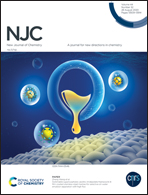Switchable superlyophobic zeolitic imidazolate framework-8 film-coated stainless-steel meshes for selective oil–water emulsion separation with high flux†
Abstract
Surfactant-stabilized oil–water emulsions are especially difficult pollutants to eliminate. Membrane technology has been extensively applied for oily water treatment. However, the immutable wettability limits its application for separating different types of emulsions. In this work, novel zeolitic imidazolate framework-8 (ZIF-8) film-coated stainless-steel meshes with switchable superlyophobicity were fabricated for all types of emulsion separations. The membranes exhibited outstanding superoleophobicity (161°) and superhydrophobicity (153°). By switching the superlyophobicity through a prewetting process, the membrane could selectively remove oil droplets in surfactant-stabilized oil-in-water emulsions via superoleophobicity and water droplets in surfactant-stabilized water-in-oil emulsions via superhydrophobicity. Upon further modification of the membrane with polyvinyl alcohol, high-flux emulsion separations were achieved. This work provides a foundation for the development of metal–organic framework (MOF) membranes for selective high-flux emulsion separations.



 Please wait while we load your content...
Please wait while we load your content...